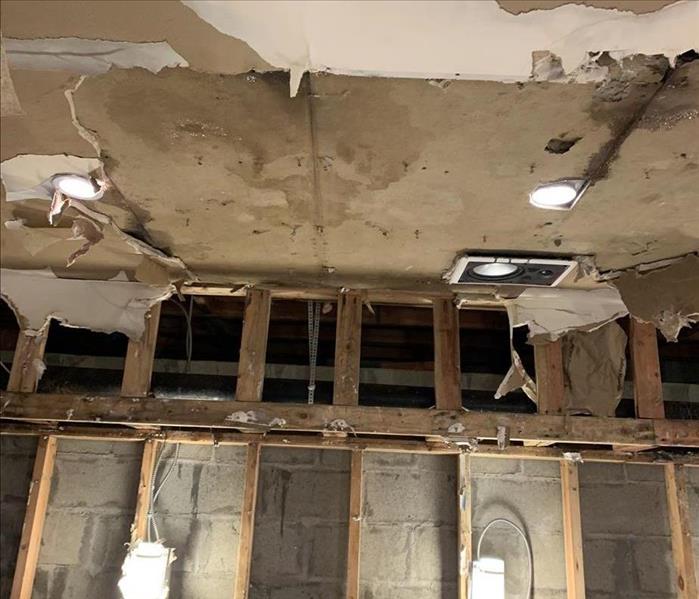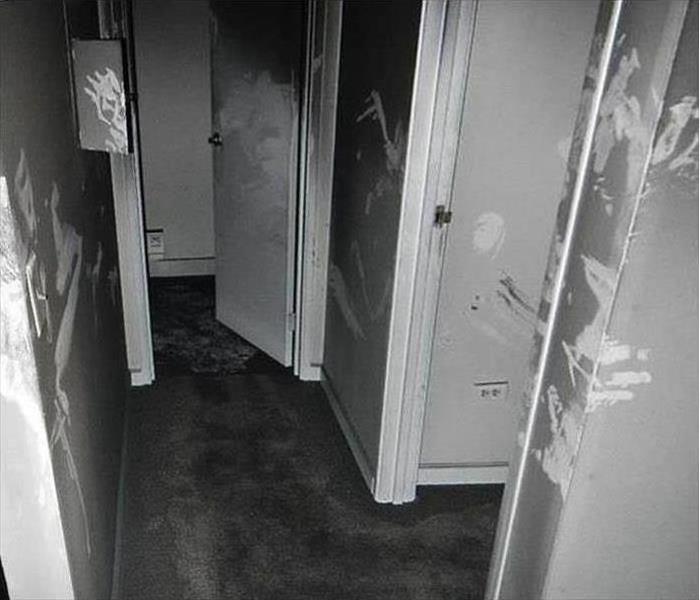Water Extraction for Multi-Story Buildings: Challenges and Best Practices
3/19/2025 (Permalink)
 If the damage affects multiple floors, walls, or ceilings, it’s best to call professionals immediately.
If the damage affects multiple floors, walls, or ceilings, it’s best to call professionals immediately.
Imagine waking up in your third-floor apartment only to find water dripping from your ceiling. A pipe burst on the fifth floor, sending water through the walls, soaking into insulation, and seeping into units below. Within hours, multiple tenants are dealing with flooded floors, damaged ceilings, and electrical hazards.
This isn’t just a nightmare—it’s a common problem in multi-story buildings, and if not handled quickly, it can cost thousands in repairs. Water damage accounts for billions in property losses each year, with insurance claims totaling $2.5 billion annually in the U.S. (The Hartford).
Whether you own a high-rise apartment, commercial building, or multi-level home, knowing how to properly extract water and dry the structure can make all the difference.
Why Water Extraction in Multi-Story Buildings is More Complicated
Unlike a single-story home, water in multi-level buildings doesn’t stay in one place. It follows gravity, spreading downward through walls, ceilings, and electrical systems, making cleanup far more difficult.
One of the biggest challenges is hidden water damage. Even after visible water is removed, moisture can remain trapped behind walls and floors, leading to long-term structural damage if not properly addressed. According to FEMA, just one inch of water in a single-story home can cause nearly $11,000 in damage, while a foot of water in a 2,500-square-foot home can result in over $29,000 in repairs. In multi-story buildings, where water spreads between multiple floors, the potential damage can escalate even further.
Additionally, shared plumbing and electrical systems in apartments or office buildings create further risks. A leak that starts in one unit can impact multiple floors and requires coordinated repairs and professional water extraction.
Best Practices for Water Extraction in Multi-Story Buildings
Step 1: Assess the Damage Immediately
The first step in any water extraction process is to understand the full extent of the damage. Professionals use moisture meters and thermal imaging cameras to detect hidden water inside walls, ceilings, and insulation.
If standing water is present, high-powered pumps and extractors are used to remove large volumes quickly. At the same time, affected areas are contained to stop the spread of water to adjacent rooms.
Step 2: Use Specialized Water Extraction Equipment
Standard household equipment isn’t enough to handle large-scale water damage. In multi-story buildings, professionals rely on specialized tools, including:
- Truck-mounted extractors – Remove high volumes of water fast.
- Weighted extraction tools – Pull moisture from carpets and padding without removing flooring.
- Industrial vacuums & pumps – Essential for removing standing water from affected floors.
Once standing water is extracted, the focus shifts to drying.
Step 3: Control Moisture & Prevent Further Damage
Water doesn’t just damage what it touches, it also creates humidity that can lead to long-term structural issues. To prevent this, professionals:
- Use commercial dehumidifiers to reduce moisture levels in the air.
- Use high-powered air movers to speed up the drying of walls, ceilings, and floors.
- Continuously monitor moisture levels to ensure all hidden water is removed.
Skipping this step can lead to future issues like warping, rot, or weakened drywall and support beams.
Water Extraction FAQs
How long does water extraction take in a multi-story building?
It depends on how much water is present and how many floors are affected. Extraction itself can take a few hours to a full day, but complete drying may take several days.
Can water damage spread between floors even after extraction?
Yes. If moisture isn’t fully removed, it can remain trapped behind walls and ceilings, leading to future structural damage. That’s why thorough drying and professional moisture detection are crucial.
Who is responsible for water damage in a multi-story building?
In rental properties, landlords or property managers are typically responsible for fixing leaks caused by plumbing or structural failures, while tenants may be responsible for damage caused by negligence (like an overflowing bathtub).
When should I call a professional water extraction company?
If the damage affects multiple floors, walls, or ceilings, it’s best to call professionals immediately. The longer you wait, the more expensive the repairs become.
Call SERVPRO of Santa Monica/Venice Beach for Expert Water Cleanup & Restoration
When dealing with water damage in a multi-story building, speed and expertise matter. At SERVPRO of Santa Monica/Venice Beach, we provide:
- 24/7 emergency water extraction
- Advanced moisture detection & drying
- Structural restoration & repairs
- Fast response times to minimize damage
Don’t let water damage spread—call SERVPRO of Santa Monica/Venice Beach today for expert multi-story water extraction and restoration.
Not All Fire Damages are Structural: What About Smoke Odor Damage?
10/5/2022 (Permalink)
 Fire damage in a home.
Fire damage in a home.
If you've ever had an odor problem in your home, then you know that it can make the place feel less than welcoming. A new house or apartment will always have some sort of odor, but it should fade after a while. When they don't, then you may have a bigger problem on your hands: smoke odor damage. Smoke damage and smoke odor are two different things that can happen after a fire breaks out in your home. The first is obvious—the fire itself caused damage to the structural integrity of your house or apartment building—while the latter is more subtle and may not be as noticeable at first glance.
How to Clean and Restore Smoke Odor Damage
There are many ways smoke odor can be cleaned and restored. It depends on the severity of the damage and what type of restoration is needed. If your home has sustained heavy structural damage from a fire, it may not be possible to completely clean or restore your home without first repairing those damages.
If you have minimal structural damage from a fire, there are still methods available for cleaning up after smoke odor in your home so that it’s livable again (and smelling fresh). The process is different depending on what kind of restoration is needed and should always be performed by professionals who know how to handle these types of situations safely.
Different Ways to Handle Smoke Odor
There are several ways to handle smoke odor after fire damage. The first is by using air filtration devices that remove harmful volatile organic compounds (VOCs). VOCs are chemicals emitted by most materials and products, including paints, finishes, and adhesives; cleaning products; gasoline fumes; wood-burning stoves; floor coverings; furniture fabrics; upholstery foams or cushions; and dry cleaning chemicals.
Another way is through the use of ozone machines which produce ozone gas that oxidizes odors at their source. This method is effective in areas where it’s very difficult to remove smoke odor from carpets or drapes because they can be difficult to clean with water alone. However, this method only works if the materials are non-porous (made without holes).
Thermal foggers work by releasing tiny droplets of perfumes into the air when activated. This helps mask odors for a short period of time, but it doesn’t really eliminate them permanently as much as masking them until new smells take over again. These have to be used every couple of weeks until eventually all smells have been masked out completely. This may sound like a good thing but there really isn't anything good about thermal fogging except maybe as an alternative solution for those who don't want their whole house smelling poorly.
Smoke Damage and Smoke Odor Can Linger
Smoke odors are usually caused by the burning of materials, such as when you cook food on a stove or make toast on a toaster. Smoke damage can also be caused by natural disasters, like wildfires or earthquakes resulting in fires.
Smoke damage is often due to a house fire, but not always; some items that are not usually considered flammable can actually burn (e.g., candles). When something burns, it leaves behind ash as well as soot that settles into the fabric of your home's interior surfaces, including walls and ceilings; grime from these surfaces will cling to other objects with which they come into contact—like your clothes!
Different Types of Smoke Damage Need Different Cleaning Processes
Smoke damage is often a combination of different odors. One of the most common types of smoke damage is caused by fire and water, which leaves behind a burnt smell. However, not all fires or disasters result in smoke damage; some can cause water damage instead.
The different types of smoke damage may need different cleaning processes. For instance, if your home sustained water damage as well as smoke odor from an accident or other disaster, you’ll want to dry out your carpet and furniture before treating it with any cleaning products that contain harsh chemicals (like bleach).
Odor Control Techniques are Used Together as Part of The Restoration Plan
Smoke odor can linger for some time, and the way that smoke odors are removed depends on the severity of the damage. If you're dealing with a small fire, you may be able to use simple techniques like baking soda and vinegar to remove smoke odors from your home or business. However, if your home or business sustained significant structural damage from a larger fire and needs extensive restoration work, odor control professionals will likely use thermal foggers and ozone machines as part of their overall restoration plan.
Smoke odors can cling to walls because they're left behind by soot particles when they settle into porous surfaces like drywall or plaster over time; these particles absorb the scent of whatever was burning at the time (e.g., wood). Some people are more sensitive than others when it comes to detecting smells—and even those who are very sensitive might have trouble detecting subtle scents—so it's important not only to get them out but also to make sure they aren't lingering somewhere else! This means using an air filtration device after everything has settled down (which is probably after all repairs have been made).
Smoke damage and smoke odor can linger for some time after a fire. The different types of smoke damage may need different cleaning processes. Odor control techniques are often used together as part of a larger restoration plan, so it’s important to have an expert on hand when working with a restoration company.

 24/7 Emergency Service
24/7 Emergency Service
